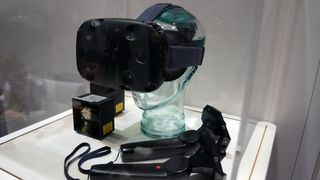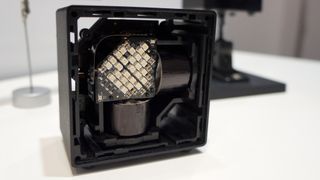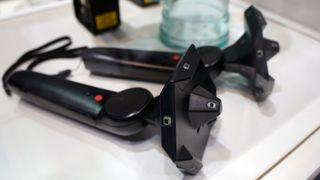SteamVR hands-on: Valve overtakes Oculus

My first real “holy shit” virtual reality experience was putting on the Oculus Rift Crescent Bay headset for the first time. I already thought VR was cool, but I’d never experienced true immersion—what Oculus likes to call presence—until Crescent Bay. It’s such a powerful feeling, when I re-tried Crescent Bay and today put on SteamVR, I was afraid I wouldn’t be able to capture it again. What if it had just been a fluke? What if my brain stopped buying it? What if the 'presence' stopped feeling so uncannily real?
Those thoughts were nagging away at the back of my mind as I put on the SteamVR (also called the HTC Vive) headset. They soon disappeared. I’m more convinced than ever that VR is a game-changer—and industry-changer—when the technology is able to convey and hold the sensation of presence. And SteamVR is the best virtual reality experience I’ve ever tried.
SteamVR uses a pair of 1200x1080 pixel displays to offer a wide field of view. The displays refresh at 90 Hz, which is fast enough to do away with most of the motion sickness issues found in earlier, lower refresh VR headsets. The Oculus Rift Crescent Bay uses a wide angle camera to perform positional tracking with dots on the headset, but SteamVR relies on a pair of laser emitters that scan the room you're playing in. These work in combination with sensors placed in the headset, and on a pair of controllers, to enable SteamVR to detect your exact position as you move around.
It’s tricky to compare Valve and Oculus’ headsets based on memory alone, but I think Crescent Bay has a slight edge when it comes to the screen. Both headsets refresh at 90Hz, but the Oculus’ screen is a bit clearer, with smaller pixels and a comparable (maybe slightly wider) field of view. SteamVR is still miles ahead of the Oculus Rift DK2, but the subpixels are noticeable, as are the gaps between pixels. Some combination of resolution and optics makes the Crescent Bay screen a slightly better experience, but both are high enough resolution to be comfortable to view and immersive with the right combination of sensory experiences.
Beyond the screen, though, I think SteamVR is ahead of Crescent Bay in every way that matters. The tracking worked flawlessly in my demo. I could move my head to look around and walk around my small room to explore the virtual environments of Valve’s demos. Oculus has repeatedly said that the Rift is a “seated experience,” even though they demo Crescent Bay standing up. Valve, meanwhile, is embracing the potential of standing up and walking around. The smartest feature of their VR software is a bounding box grid overlay that appears on screen when you approach a wall in the physical world. With the consumer headset, you’ll be able to precisely define the walls of your room, and the positional tracking system will alert you when you get too near to one. Another smaller area is highlighted around your feet to show the recommended “safe zone” for walking, well away from any walls.

In one demo I was under the sea on the deck of a wrecked ship. Fish darted around me, and I peered over the prow to stare down into a rocky canyon below. When I walked across the deck, a neon blue grid appeared a couple feet in front of me—think the Star Trek holodeck when it’s deactivated—that represented one of the walls of my room. I reached out to touch it, and sure enough, it was exactly where it should be.
Valve’s biggest advantage over Oculus, though, are its in-house controllers. The pair of VR controllers resemble Sony’s PlayStation Move, but replace the big glowy balls with sensor arrays resembling small satellite dishes. The controllers have a trigger on the back where your index fingers rest, and a clickable thumbpad on the front just like the twin trackpads on the Steam controller. That thumbpad can be sliced up into different 'buttons'—to teach you how to use it in the very first demo, Valve has the circle split into a dozen or so wedges that correspond to different colors. Clicking one and then pulling the trigger blows a yellow or green or purple (etc. etc.) balloon. You can also squeeze the "grip" of the controller to perform another action.
The biggest gaming news, reviews and hardware deals
Keep up to date with the most important stories and the best deals, as picked by the PC Gamer team.
Because the controllers have tracking sensors on them as well, they show up in games exactly where your hands should be. It’s a huge boon for the immersion of VR. More importantly, the controllers offer a better way to interact with VR games than a typical gamepad. At least, some types of VR games. Developers may find that they want an analog stick to control movement (though I think the trackpads may work well for that purpose), but Valve’s controllers offer a much closer analogue to hands for interacting with a virtual environment.
One of the demos was clearly designed to showcase how effective the controllers are as hand analogues. It put me in a cartoony kitchen and tasked me with making soup and a sandwich by combining different ingredients. I had to look around the room, spot some mushrooms and tomatoes, and pick them up by pulling the trigger on the controller, which was represented in the virtual world by a cartoony gloved hand. At first, my instincts with motion controls made me aim at the ingredients and press the trigger. Nothing happened. Then I realized I had to actually reach out and put my hand in the right place in 3D space to click again and grab the ingredients.
The controller tracking feels extremely accurate and responsive, and I like the clicky feedback of the thumbpads and the triggers. I can't say how well the controllers will work for all types of games in VR, but for Valve's simple demos, they're far better than any gamepad VR experience I've had.
Having the positioning of my hands tracked did make me realize how strange it is not to see my arms or legs or torso represented virtually. I felt especially disembodied in Valve’s sequence of demos, but that’s something I’m sure future games will account for.
One problem Valve hasn’t solved yet is cable management. The VR controllers will ultimately be wireless, but the demo model has a belt that you strap around your waist to help keep the various cables under control. It’s not enough to completely solve the problem, though. I walked around the room to explore the boundaries of each demo as much as I could, and ended up wrapping the cables around my feet a couple times. Because I was moving slowly and carefully, disentangling myself was as simple as rotating in the opposite direction I’d moved to get myself tangled in the first place. But if I’d been playing, say, a high-speed first-person shooter, I could’ve easily tripped myself and damaged something. Or myself.

The demos did just as great a job at selling presence as Oculus’ reel of Crescent Bay experiences. One of my favorites was a simple paint program for drawing in 3D—something about the accuracy of the tracking, coupled with the controller, made pointing and drawing in 3D powerfully satisfying. It was like recreating an awesome long-exposure photograph of someone waving around a flashlight, then being able to walk around and look at it it in three dimensions.
The best, of course, was Valve’s Portal-themed demo, which is sadly not Portal 3. The five minute slice of Aperture made me realize how much I miss Valve’s attention to detail and touch for comedic timing. The demo places you in a room in Aperture labs; Portal 2’s ATLAS robot walks in, and a disembodied voice in the testing facility asks you to open him up to fix a malfunction. It was funny, of course. The demo is barely interactive, but I peered into an exploded-out view of ATLAS’s robot guts, leaning in and out, and never lost my feeling of presence. The same held true for the entire 15 minutes I was wearing the headset, in fact, except when I intentionally broke presence by stepping through a railing, or looked down and noticed I didn’t have a body.
Valve plans to launch developer kits of SteamVR this spring, with a consumer release promised for November. Cost is still a giant looming question mark, however, and as convincing as Valve’s demos were, the amount of content at launch will be interesting too. Will there be true VR games we want to play on day one? The feeling of presence is greatly enhanced by being able to stand and walk around, but it's also going to require an entirely new way of designing game environments and player movement. Most people will be walking around in their living rooms, with only a few feet of space to spare on any side. Will VR games put us on rails, and let us walk around in a small radius? Or will designers teleport us from one space to another? Will AI characters take tracking data into account so they don’t collide with your virtual body, shattering immersion? As incredibly exciting as SteamVR is, much remains to be discovered.
Virtual reality is a long, long way from being a completely solved problem. But from what I’ve seen, Valve’s hardware is good enough to support an audience of serious gamers, not just developers and early adopters. Now we just need something play on it.

Wes has been covering games and hardware for more than 10 years, first at tech sites like The Wirecutter and Tested before joining the PC Gamer team in 2014. Wes plays a little bit of everything, but he'll always jump at the chance to cover emulation and Japanese games.
When he's not obsessively optimizing and re-optimizing a tangle of conveyor belts in Satisfactory (it's really becoming a problem), he's probably playing a 20-year-old Final Fantasy or some opaque ASCII roguelike. With a focus on writing and editing features, he seeks out personal stories and in-depth histories from the corners of PC gaming and its niche communities. 50% pizza by volume (deep dish, to be specific).
Most Popular


